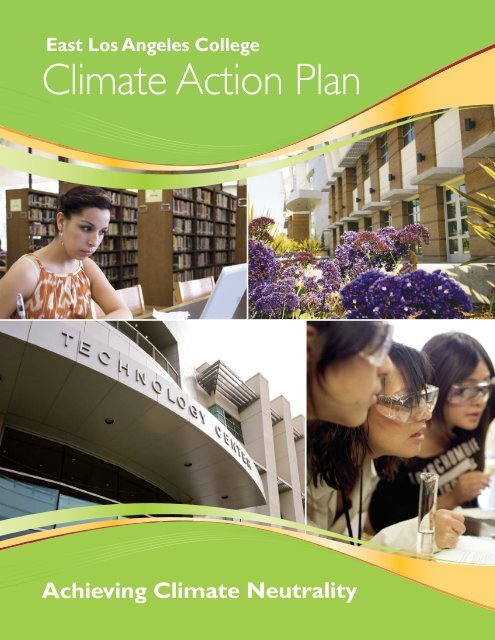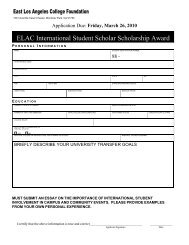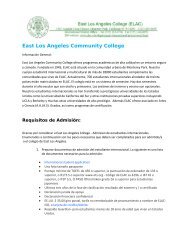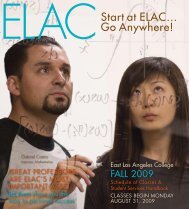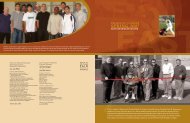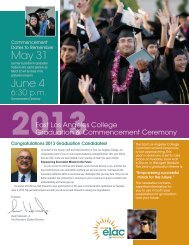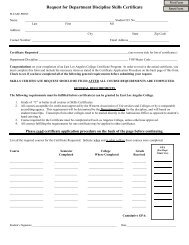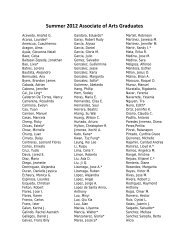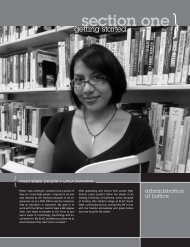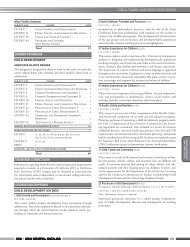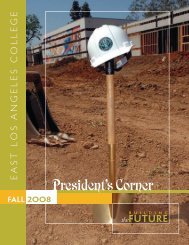Climate Action Plan - East Los Angeles College
Climate Action Plan - East Los Angeles College
Climate Action Plan - East Los Angeles College
Create successful ePaper yourself
Turn your PDF publications into a flip-book with our unique Google optimized e-Paper software.
<strong>East</strong> <strong>Los</strong> <strong>Angeles</strong> <strong>College</strong><br />
<strong>Climate</strong> <strong>Action</strong> <strong>Plan</strong><br />
Achieving <strong>Climate</strong> Neutrality
Acknowledgements<br />
LOS ANGELES COMMUNITY COLLEGE DISTRICT<br />
BOARD OF TRUSTEES<br />
Georgia L. Mercer, President<br />
Miguel Santiago, First Vice President<br />
Nancy Pearlman, Second Vice President<br />
Kelly Candaele<br />
Mona Field<br />
Tina Park<br />
Sylvia Scott-Hayes<br />
Linda L. Tong, Student Trustee<br />
Chancellor<br />
Daniel LaVista, Ph.D.<br />
EAST LOS ANGELES COLLEGE<br />
President<br />
Ernest H. Moreno
Contents<br />
Introduction . . . . . . . . . . . . . . . . . . . . . . . . . . . . . . . . . . . . . . . . . . . . . .2<br />
<strong>Climate</strong> Change Affects the World, Our Nation, and Our<br />
Communities… and, We Effect <strong>Climate</strong> Change . . . . . . . . . . . . . . . . . . .4<br />
New Lessons in Higher Education . . . . . . . . . . . . . . . . . . . . . . . . . .5<br />
<strong>Los</strong> <strong>Angeles</strong> Community <strong>College</strong> District . . . . . . . . . . . . . . . . . . . . .6<br />
Doing Our Part at <strong>East</strong> <strong>College</strong> . . . . . . . . . . . . . . . . . . . . . . . . . . . . .8<br />
Our Course for a <strong>Climate</strong> <strong>Action</strong> <strong>Plan</strong> . . . . . . . . . . . . . . . . . . . . . . . .9<br />
Building a Baseline Greenhouse Gas Inventory . . . . . . . . . . . . . . . . . . . .11<br />
Emissions Forecast and Achieving <strong>Climate</strong> Neutrality . . . . . . . . . . . . . . .15<br />
<strong>Climate</strong> <strong>Action</strong> Strategies . . . . . . . . . . . . . . . . . . . . . . . . . . . . . . . . . . . .17<br />
Buildings . . . . . . . . . . . . . . . . . . . . . . . . . . . . . . . . . . . . . . . . . . . .17<br />
Renewable Energy . . . . . . . . . . . . . . . . . . . . . . . . . . . . . . . . . . . . .23<br />
Transportation . . . . . . . . . . . . . . . . . . . . . . . . . . . . . . . . . . . . . . . .24<br />
Operations . . . . . . . . . . . . . . . . . . . . . . . . . . . . . . . . . . . . . . . . . . .25<br />
Education, Community Outreach, and Research . . . . . . . . . . . . . .26<br />
Monitoring and Tracking Progress . . . . . . . . . . . . . . . . . . . . . . . . . . . . .28<br />
Work with Us on Our <strong>Climate</strong> <strong>Action</strong> <strong>Plan</strong> . . . . . . . . . . . . . . . . . . . . . . .28<br />
i
INTRODUCTION<br />
<strong>East</strong> <strong>Los</strong> <strong>Angeles</strong> <strong>College</strong> is on a quest to become climate neutral by 2050.<br />
We’re serious about this quest: We made an official commitment to it by agreeing<br />
to the American <strong>College</strong> and University President’s <strong>Climate</strong> Commitment in 2007.<br />
How do we get there<br />
<strong>East</strong> <strong>Los</strong> <strong>Angeles</strong> <strong>College</strong> (ELAC) has taken the initial steps. We have developed<br />
our baseline greenhouse gas inventory, determined our strategies, and begun to<br />
implement measures. Now, our climate action plan will guide us toward achieving<br />
greenhouse gas emission reductions and climate neutrality. This critical tool is a<br />
roadmap into our future. It will help us monitor progress, measure outcomes, and<br />
be accountable.<br />
Our climate action plan outlines strategies and milestones to lead ELAC students,<br />
faculty, and staff through the next 40 years. This is a crucial time period during<br />
which our actions, along with those of institutions, businesses, and governments<br />
around the world, will largely determine the world’s fate with global warming.<br />
As our climate action plan progresses, we have many responsibilities:<br />
■ We have to dedicate our efforts to short-, medium-, and long-term tasks.<br />
■<br />
■<br />
■<br />
■<br />
We have to learn new thought processes, knowledge fields, techniques, and<br />
cutting-edge technologies to apply new processes and introduce new solutions.<br />
We also have to embrace lessons from unintended or unexpected results.<br />
We have to be resourceful and collaborative. We have to acquire skills and<br />
knowledge from institutions experienced in certain project areas, and we<br />
have to share best practices and experiences with institutions tackling new<br />
challenges, in which we have gained insights.<br />
We have to be adaptable to changes for a better future, be patient through<br />
processes, and be flexible in adjusting our course when called for by<br />
external factors.<br />
We have to recognize the small wins and the major accomplishments.<br />
Most importantly, for our climate action plan to succeed, we must<br />
ensure two conditions are consistently met:<br />
■ Everyone at ELAC must be involved: students, faculty, administrators,<br />
and staff. We hope everyone will be actively engaged as we execute our<br />
plan and work together towards an environmentally and economically<br />
sustainable future for all.<br />
■<br />
<strong>Climate</strong> action plan strategies and tactics must align with our vision:<br />
to be an exemplary model for student academic, technological and<br />
artistic achievement.<br />
2
CLIMATE CHANGE<br />
IMPACTS OUR<br />
WORLD, OUR<br />
NATION AND<br />
OUR COMMUNITY
<strong>Climate</strong> Change Affects the World, Our<br />
Nation, and Our Communities…and,<br />
We Effect <strong>Climate</strong> Change<br />
<strong>Climate</strong> change presents one of the most<br />
profound challenges of our time. A broad<br />
international consensus exists among atmospheric<br />
scientists that Earth’s climate system<br />
is changing in response to elevated levels of<br />
greenhouse gas emissions in the atmosphere<br />
primarily from the combustion of fossil fuels<br />
for energy use.<br />
Global <strong>Climate</strong> Change Impacts in the<br />
United States 1 — a few key findings:<br />
1. Global warming is unequivocal and<br />
primarily human-induced.<br />
Global temperature has increased over<br />
the past 50 years. This observed increase<br />
is primarily due to human-induced<br />
emissions of heat-trapping gases.<br />
2. <strong>Climate</strong> changes are underway in the<br />
United States and are projected to grow.<br />
<strong>Climate</strong>-related changes have already<br />
been observed in the United States and<br />
its coastal waters. These include increases<br />
in heavy downpours, rising temperature<br />
and sea level, rapidly retreating glaciers,<br />
thawing permafrost, lengthening growing<br />
seasons, lengthening ice-free seasons in<br />
the ocean and on lakes and rivers, earlier<br />
snowmelt, and alterations in river flows.<br />
These changes are projected to grow.<br />
3. Widespread climate-related impacts<br />
are now occurring and are expected<br />
to increase.<br />
<strong>Climate</strong> change is already affecting water,<br />
energy, transportation, agriculture,ecosystems,<br />
and health. These impacts are<br />
different from region to region and will<br />
grow under projected climate changes.<br />
4. Future climate change and its impacts<br />
depend on choices made today.<br />
The amount and rate of future climate<br />
change depend primarily on current and<br />
future human-caused emissions of heattrapping<br />
gases and airborne particles.<br />
Responses involve reducing emissions<br />
to limit future warming, and adapting<br />
to the changes that are unavoidable.<br />
We need to reduce greenhouse<br />
gas emissions: 2,3<br />
■ Over the next century, limiting the increase<br />
in average global temperature to 2°C may<br />
avoid the most damaging and irreversible<br />
impacts of global warming.<br />
■<br />
■<br />
Greenhouse gas emissions need to be<br />
stabilized well below 450 parts per<br />
million to minimize the average global<br />
temperature increase to 2°C.<br />
Global greenhouse gas emissions must<br />
be reduced by at least 50% of their 1990<br />
levels by the year 2050, in order to reduce<br />
the risks of severe climate change.<br />
4<br />
1. U.S. Global Change Research Program (USGCRP) 2009. “Global <strong>Climate</strong> Change Impacts in the United States.” Page 12.<br />
http://www.globalchange.gov/publications/reports/scientific-assessments/us-impacts This report was issued in 2009, by a task force of<br />
U.S. government science agencies led by the National Oceanic and Atmospheric Administration (NOAA).<br />
2. International <strong>Climate</strong> Change Task force. “Meeting the Challenge of <strong>Climate</strong> Change.” 2005. http://www.americanprogress.org/kf/climatechallenge.pdf<br />
3. University of New South Wales <strong>Climate</strong> Change Research Centre. http://www.ccrc.unsw.edu.au/news/2007/Bali.html 2007 Bali Declaration by Scientists.
New Lessons in Higher Education<br />
We have all contributed to the progression<br />
of climate change, and we all have a role<br />
in changing its course.<br />
<strong>College</strong>s and universities have a pivotal role<br />
in advancing sustainable business practices,<br />
since we have a great influence on our next<br />
generation of young professionals. We have<br />
a responsibility to lead our students on the<br />
right course, through learning opportunities<br />
that empower them to understand climate<br />
change, make decisions for sustainable<br />
living, and use new skills to build a safer<br />
and healthier future.<br />
Higher education is a billion dollar economic<br />
engine: We employ millions of people;<br />
consume vast resources, manufactured<br />
goods, and services; and cater to more than<br />
17 million students who are attending the<br />
more than 4,000 higher learning institutions<br />
in the United States. 4 Students will pursue<br />
many different careers, and they will have<br />
an impact on businesses, organizations, and<br />
operations of all types. They need to acquire<br />
knowledge and skills in new disciplines to<br />
effect positive change.<br />
Higher education is in the best position<br />
to not only teach our next generations<br />
the critical lessons and tools to create<br />
a new course for our future, but also to<br />
take actions as an institution to model<br />
ways that can help foster improved<br />
climate conditions.<br />
The American <strong>College</strong> & University Presidents’ <strong>Climate</strong> Commitment is a growing<br />
network of colleges and universities that have committed to develop and implement<br />
plans in pursuit of climate neutrality. 5<br />
Higher education has been granted tax-free status, the ability to receive public and private<br />
funds, and academic freedom, in exchange for educating students and producing the<br />
knowledge that will result in a thriving civil society. For these reasons, higher education<br />
has a moral and social responsibility to rise to this challenge. 6<br />
American <strong>College</strong> & University Presidents’ <strong>Climate</strong> Commitment.<br />
4. ACUPCC Website “Why Sign the Commitment” http://www.presidentsclimatecommitment.org/about/commitment/why-sign<br />
5. ACUPCC Website “Mission and History” http://www.presidentsclimatecommitment.org/about/mission-history<br />
6. ACUPCC Website “Why Sign the Commitment” http://www.presidentsclimatecommitment.org/about/commitment/why-sign<br />
5
<strong>Los</strong> <strong>Angeles</strong> Community <strong>College</strong> District<br />
The <strong>Los</strong> <strong>Angeles</strong> Community <strong>College</strong> District<br />
(LACCD) is the largest community college<br />
district in the United States. It has nine<br />
colleges, including <strong>East</strong> <strong>Los</strong> <strong>Angeles</strong> <strong>College</strong>,<br />
and it covers an area greater than 882 square<br />
miles in more than 36 cities and communities.<br />
LACCD offers lifelong learning opportunities<br />
for students.<br />
As a higher education institutional system,<br />
LACCD recognized its responsibility to<br />
reduce greenhouse gas emissions. Former<br />
LACCD Chancellor Darroch Young and the<br />
current Chancellor Daniel LaVista also understood<br />
the urgency to take action. The District<br />
became one of the 12 founding signatories of<br />
the American <strong>College</strong> & University Presidents’<br />
<strong>Climate</strong> Commitment (ACUPCC) in 2006.<br />
LACCD has been a rising leader in advancing<br />
sustainable practices. Its hallmark initiative is<br />
the $6 billion Sustainable Building Program<br />
to replace buildings in states of disrepair<br />
and neglect.<br />
LACCD Firsts:<br />
■ First community college system<br />
to require LEED certification for<br />
new buildings<br />
■ First community college system<br />
to achieve a BREEAM (BRE<br />
Environmental Assessment<br />
Method) certification<br />
■ First community college system<br />
to sign on to the ACUPCC<br />
<strong>Climate</strong> Commitment<br />
■ First community college system<br />
to host the UC/CSU/CCC Annual<br />
Sustainability Conference<br />
■ First community college system<br />
to join the California <strong>Climate</strong><br />
<strong>Action</strong> Registry<br />
6
LACCD Awards and Recognitions<br />
2010<br />
IIDA Caliber Environmental Leadership Award for commitment to sustainability and<br />
influence on the broader community (International Interior Design Association)<br />
2009<br />
Sustainability Showcase Award, Other Products and Services category (California<br />
Sustainability Alliance)<br />
Community Impact Award (<strong>Los</strong> <strong>Angeles</strong> Business Council)<br />
Higher Education Energy Efficiency Best Practices award (UC/CSU/CCC Sustainability<br />
Conference)<br />
Green California Leadership Award (Green Technology and Advisory Board for the<br />
Green Calif. Summit)<br />
Sustainable Leadership and Design Development Non-Profit award (CoreNet Global)<br />
Leonardo Public Sector Industry Honor Award (Society for Marketing Professional<br />
Services, <strong>Los</strong> <strong>Angeles</strong> Chapter)<br />
2008<br />
Green Leadership Achievement Award (Green California Community <strong>College</strong> Summit)<br />
REmmy Corporate Citizens Award (CoreNet Global)<br />
Energy Efficiency Partnership Program Best Practices in New Construction &<br />
Sustainable Operations (UC/CSU/CCC Sustainability Conference)<br />
2007<br />
Clinton <strong>Climate</strong> Initiative<br />
Governor's Environmental and Economic Leadership Award - Sustainable Practices<br />
or Facilities<br />
California Construction Owner of the Year - McGraw Hill (California Construction<br />
Magazine)<br />
2006<br />
Savings by Design Award (Southern California Gas Company)<br />
Sustainable Future Award (U.S. Green Building Council - <strong>Los</strong> <strong>Angeles</strong> Chapter)<br />
Flex Your Power (State of California)<br />
2005<br />
Flex Your Power Education and Leadership (State of California)<br />
Visionary Leadership Award (U.S. Green Building Council - <strong>Los</strong> <strong>Angeles</strong> Chapter)<br />
Sempra Energy Efficiency Excellence Award<br />
2004<br />
California/Local Environmental Leadership Award (Global Green U.S.A.<br />
Millennium Awards)<br />
Visionary Award (U.S. Green Building Council)<br />
Flex Your Power Award (State of California)<br />
7
Doing Our Part at <strong>East</strong> <strong>Los</strong> <strong>Angeles</strong> <strong>College</strong><br />
<strong>East</strong> <strong>Los</strong> <strong>Angeles</strong> <strong>College</strong> is a two-year<br />
college that has been educating students<br />
for over 62 years, throughout its 82-acre<br />
campus on Avenida Cesar Chavez in<br />
Monterey Park, Calif. We have an international,<br />
multicultural student body that we<br />
serve in our dynamic urban setting.<br />
Our campus is undergoing<br />
a transformation.<br />
From our buildings and curriculum to our<br />
administration and operations, we are making<br />
physical, environmental, and social changes<br />
to improve <strong>East</strong> <strong>Los</strong> <strong>Angeles</strong> <strong>College</strong>.<br />
We are dedicated to creating a more sustainable future.<br />
FLORAL DRIVE<br />
cs<br />
cm<br />
1<br />
6<br />
A B 7<br />
8<br />
9<br />
bs<br />
bk bl<br />
bt<br />
br<br />
bq<br />
cl<br />
ck cm<br />
cr<br />
ct<br />
cq<br />
cn<br />
COLLEGIAN AVENUE<br />
5<br />
bm bn bo<br />
bp<br />
cn<br />
cp<br />
2<br />
co<br />
dl<br />
dk<br />
dn<br />
3<br />
4<br />
AVENIDA CESAR CHAVEZ<br />
dm<br />
1 PARKING STRUCTURE<br />
2 FINE ARTS COMPLEX<br />
3 VINCENT PRICE ART GALLERY<br />
4 AUTO TECHNOLOGY<br />
5 PERFORMING ARTS COMPLEX<br />
6 CLASSROOMS<br />
7 CLASSROOMS<br />
8 PLANT FACILITIES (AB)<br />
9 CLASSROOMS<br />
bk NURSING<br />
bl MATH & SCIENCE LECTURE HALL<br />
bm MATH & SCIENCE CLASSROOMS<br />
bn EDISON CENTER INGALLS AUDITORIUM<br />
bo ADMINISTRATION<br />
bp BAILEY LIBRARY<br />
bq CAMPUS CENTER BOOKSTORE<br />
br CLASSROOMS<br />
bs MULTI-PURPOSE ATHLETIC FIELD<br />
bt WOMEN’S SOFTBALL FIELD<br />
ck WOMEN’S GYM<br />
cl TECHNOLOGY/LEARNING CENTER<br />
cm CAMPUS QUAD<br />
cn STUDENT SUCCESS & RETENTION CNTR<br />
co STUDENT SERVICES<br />
cp PARKING STRUCTURE<br />
cq SWIM STADIUM<br />
cr FACULTY OFFICES<br />
cs CENTRAL PLANT<br />
ct ELAC STADIUM<br />
dk MEN’S GYM / FITNESS CENTER<br />
dl SOCCER FIELD<br />
dm CHILD DEVELOPMENT CENTER<br />
dn MEN’S BASEBALL FIELD<br />
do STADIUM LOT<br />
do<br />
BLEAKWOOD AVENUE<br />
EXISTING BUILDINGS<br />
NEW BUILDINGS<br />
MODERNIZED BUILDINGS<br />
UNDER CONSTRUCTION<br />
8
Our Course for a <strong>Climate</strong> <strong>Action</strong> <strong>Plan</strong><br />
Cultivating campus sustainability is a<br />
cornerstone of the <strong>East</strong> <strong>Los</strong> <strong>Angeles</strong><br />
<strong>College</strong> climate action plan.<br />
■<br />
Integrate sustainability into the<br />
curriculum and make it part of<br />
the educational experience<br />
As a signatory of the American <strong>College</strong> &<br />
University Presidents’ <strong>Climate</strong> Commitment,<br />
<strong>East</strong> <strong>Los</strong> <strong>Angeles</strong> <strong>College</strong> agreed to:<br />
■<br />
Develop a climate action plan that<br />
outlines strategies and tactics to<br />
achieve climate neutrality<br />
■<br />
■<br />
■<br />
Complete a greenhouse gas<br />
emissions inventory<br />
Set a target date for becoming<br />
climate neutral<br />
Take immediate steps to reduce<br />
greenhouse gas emissions<br />
Here, in our climate action plan, we highlight<br />
strategies and tactics that will enable<br />
<strong>East</strong> <strong>Los</strong> <strong>Angeles</strong> <strong>College</strong> to minimize<br />
greenhouse gas emissions and meet our<br />
social mandate to help create a thriving,<br />
ethical and sustainable society.<br />
9
ESTABLISHING<br />
A BASELINE
Building a Baseline Greenhouse<br />
Gas Inventory<br />
In 2005, <strong>East</strong> <strong>Los</strong> <strong>Angeles</strong> <strong>College</strong> joined the<br />
California <strong>Climate</strong> <strong>Action</strong> Registry (CCAR).<br />
That year, LACCD conducted a greenhouse<br />
gas (GHG) emissions inventory of the 2004<br />
calendar year to establish a baseline for each<br />
of its nine campuses and the District Office.<br />
LACCD has conducted subsequent inventories<br />
for 2005 through 2009.<br />
ELAC’s greenhouse gas inventory accounts<br />
for emissions in three categories:<br />
■<br />
■<br />
■<br />
Consumption of natural gas in campus<br />
buildings and other onsite combustibles,<br />
such as gasoline-driven lawn mowers<br />
and diesel back-up generators<br />
Electricity consumption in campus<br />
buildings<br />
Gasoline and diesel fuel consumption for<br />
student, faculty and staff commuting<br />
Since we began measuring and monitoring<br />
our GHG emissions, <strong>East</strong> <strong>Los</strong> <strong>Angeles</strong> <strong>College</strong><br />
has undergone numerous facility changes,<br />
which include the Administration Building<br />
renovation and construction of a new<br />
Performing Arts and Fine Arts Complex.<br />
However, campus emissions have remained<br />
relatively the same, with a recent downward<br />
trend after a period of slight increase.<br />
■<br />
■<br />
■<br />
In 2008, natural gas used for space- and<br />
water-heating decreased 22% from<br />
2007, likely due to the demolition of<br />
a number of campus buildings.<br />
Emissions from building electricity<br />
consumption decreased from 2007 to<br />
2008, due to the demolition activities<br />
and the installation of a 1 MW solar<br />
photovoltaic array.<br />
Emissions from commuting are estimated<br />
to rise as the student population is<br />
projected to increase. 7<br />
The Kyoto Protocol is a protocol<br />
to the United Nations Framework<br />
Convention on <strong>Climate</strong> Change<br />
(UNFCCC). The agreement identifies<br />
six high priority greenhouse gases<br />
for reductions:<br />
■<br />
■<br />
■<br />
■<br />
■<br />
■<br />
Carbon dioxide (CO2)<br />
Methane (CH4)<br />
Nitrous Oxide (N2O)<br />
Hydroflourocarbons (HFCs)<br />
Perflourocarbons (PFCs)<br />
Sulfur hexafluoride (SF6)<br />
<strong>Climate</strong> Leader Recognized by California <strong>Climate</strong> <strong>Action</strong> Registry (CCAR)<br />
ELAC follows the CCAR General Reporting Protocol to collect,<br />
calculate, and report GHG emissions data.<br />
ELAC’s 2007, 2008 and 2009 inventories have been adjusted<br />
to include all six greenhouse gases.<br />
A third party verifies all of ELAC’s data collected.<br />
ELAC’s annual emissions reports are included in the LACCD GHG emissions reports<br />
available to the public on the CCAR website, www.climateregistry.org/.<br />
7. <strong>East</strong> <strong>Los</strong> <strong>Angeles</strong> <strong>College</strong>, Facilities Master <strong>Plan</strong> 2009<br />
11
What is a metric ton of carbon dioxide equivalent (MTCO2e)<br />
Each of the six Kyoto greenhouse gases has different global warming potentials, meaning<br />
they have differing abilities to trap heat in the atmosphere. The total emissions of all six<br />
greenhouse gases are normalized according to their global warming equivalence to a<br />
molecule of carbon dioxide (CO2e). And a metric ton is approximately 2,204 pounds!<br />
12
Building Electricity<br />
<strong>East</strong> <strong>Los</strong> <strong>Angeles</strong> <strong>College</strong> campus buildings<br />
typically use electricity for lighting, motors,<br />
fans, heating and cooling systems, and plug<br />
loads, such as computers. We purchase<br />
electricity from Southern California Edison.<br />
We purchased 10,088 megawatt-hours<br />
(MWh) of electricity from Southern<br />
California Edison in 2008, equivalent<br />
to 2,931 MTCO2e.<br />
In 2004, ELAC student, staff, and faculty<br />
commuters were responsible for 7,415<br />
MTCO2e of indirect mobile (gasoline and<br />
diesel) emissions.<br />
This number has remained relatively consistent<br />
through 2007, but it is projected to<br />
increase as our student population increases.<br />
Building Natural Gas<br />
As of 2008, the main sources of natural gas<br />
consumption are space heating and water<br />
heating equipment. 8 The Southern California<br />
Gas Company supplies this natural gas.<br />
We purchased 186,079 therms of natural<br />
gas from Southern California Gas<br />
Company, equivalent to 990 MTCO2e.<br />
Transportation Fuels<br />
Commuting is part of everyday life at a<br />
community college, for faculty, staff, and<br />
students, alike.<br />
8. <strong>Los</strong> <strong>Angeles</strong> Community <strong>College</strong> District, Greenhouse Gas Emissions Inventory Verification Report, 2008, Appendix D<br />
13
ACHIEVING<br />
CLIMATE<br />
NEUTRALITY
Emissions Forecast and Achieving<br />
<strong>Climate</strong> Neutrality<br />
Global greenhouse gas emissions must be<br />
reduced 50-80% by 2050 to avoid dramatic<br />
consequences of climate change.<br />
■<br />
The Sustainable Building Program’s<br />
new construction projects planned<br />
through 2015<br />
California has committed to reduce GHG<br />
emissions by 80% of its 1990 levels, by 2050. 9<br />
<strong>East</strong> <strong>Los</strong> <strong>Angeles</strong> <strong>College</strong> will go beyond<br />
the recommended reduction goal for<br />
GHG emissions to achieve climate<br />
neutrality by 2050.<br />
A climate action plan must state an emissions<br />
forecast. This forecast helps foster a concerted<br />
effort to implement emission reduction<br />
projects, and it establishes a comparative<br />
measure between future emission reductions<br />
and business-as-usual (BAU) emission levels<br />
to track progress.<br />
The emissions forecast for <strong>East</strong> <strong>Los</strong> <strong>Angeles</strong><br />
<strong>College</strong> is based on several factors:<br />
■<br />
The emissions trend calculated from<br />
2004 through 2009<br />
■<br />
A rough estimate of the emissions trends<br />
for ELAC’s continued expansion at our<br />
two satellite locations through 2025:<br />
the South Gate Education Center and<br />
the ELAC Rosemead Center<br />
What is <strong>Climate</strong> Neutrality<br />
According to the ACUPCC, climate<br />
neutrality is defined as having no<br />
net GHG emissions.<br />
<strong>Climate</strong> neutrality can be achieved<br />
by minimizing GHG emissions as<br />
much as possible, prior to considering<br />
carbon offsets or other offsite<br />
mitigation measures.<br />
9. Executive Order S-3-05, signed by Governor Schwarzenegger in 2005<br />
15
IMPROVING<br />
CAMPUS<br />
LIFE
<strong>Climate</strong> <strong>Action</strong> Strategies<br />
<strong>East</strong> <strong>Los</strong> <strong>Angeles</strong> <strong>College</strong>’s climate action strategies target the largest sources of greenhouse<br />
gas emissions: buildings and transportation.<br />
Buildings<br />
DISTRICT-WIDE SUSTAINABLE BUILDING PROGRAM<br />
In 2002, the <strong>Los</strong> <strong>Angeles</strong> Community <strong>College</strong> District Board of Trustees adopted<br />
a groundbreaking commitment to sustainability — a sustainable policy mandate<br />
that requires a LEED-certified rating or better for all new construction and major<br />
renovation projects throughout its college campuses. Today, the LACCD is at<br />
the helm of a $6 billion Sustainable Building Program, which is among the<br />
nation’s largest environmentally friendly green-building programs.<br />
The Sustainable Building Program cultivates positive impacts for society:<br />
■<br />
Creates improved environments that are better suited to prepare and<br />
train students for twenty-first century jobs<br />
■ Boosts the California economy<br />
■ Models sustainable practices and decreases the District’s GHG emissions<br />
To supplement the Board’s policy, a sustainable standards and specification was<br />
launched to give designers guidelines to focus their efforts on conserving energy,<br />
integrating sustainable siting design, reducing waste and water consumption,<br />
improving indoor air quality, and using sustainable materials and resources.<br />
All buildings will be designed and constructed with environmental<br />
sensitivity in mind.<br />
17
LACCD Building Measures to Reduce Greenhouse<br />
Gas Emissions and Improve Campus Sustainability<br />
Water use measures<br />
■<br />
■<br />
■<br />
■<br />
Collect all stormwater so none shall<br />
leave the campus: store collected<br />
stormwater to re-use or infiltrate onsite<br />
Reduce potable water demand for all<br />
landscaping by a minimum of 50%:<br />
utilize Xeriscaping and drought<br />
resistant planting<br />
Reuse and collect greywater<br />
Reduce potable water demand for<br />
buildings by at least 40%: install<br />
waterless urinals in all new and<br />
existing buildings<br />
Energy use measures<br />
■<br />
Reduce the heat island effect: use cool<br />
roofs and appropriate materials, such<br />
as green roofs where applicable and<br />
less dark materials like asphalt<br />
■ Design new buildings to exceed Title 24<br />
by 20%, and major renovations to<br />
exceed Title 24 by 10%<br />
■<br />
■<br />
Measure and verify energy use and analyze<br />
system trends to optimize building<br />
operations and energy performance<br />
Conduct whole-building enhanced<br />
commissioning to ensure systems are<br />
operating as designed and maximize<br />
energy efficiency<br />
Renewable energy generation<br />
measures<br />
■<br />
■<br />
Use photoluminescent exit signage,<br />
which harnesses solar power, thereby<br />
reducing electricity demand from<br />
electric-powered exit signs<br />
Generate at least 10% of each building’s<br />
energy through renewable technologies<br />
What is Title 24<br />
Title 24 of the California Code of Regulations,<br />
also known as the California Building<br />
Standards Code, contains the regulations<br />
that govern the energy consumption<br />
standards for buildings.<br />
18
Material reuse and recycling measures<br />
■<br />
■<br />
■<br />
Ensure 90% of materials generated from<br />
construction and demolition activities are<br />
diverted from landfills: recycle, reuse, or<br />
repurpose a minimum of 90% marketable<br />
materials. LACCD’s goal is to divert 100%<br />
of all construction and demolition waste<br />
from landfills.).<br />
Use recycled carpet that comprises<br />
100% recycled content for the backing<br />
and up to 75% recycled content for<br />
the carpet fiber.<br />
Use 35% fly ash in concrete, which<br />
contributes to recycled content use.<br />
As many as 13 <strong>East</strong> <strong>Los</strong> <strong>Angeles</strong> <strong>College</strong><br />
campus buildings will continue to undergo<br />
facility renovations and new construction<br />
through 2015. We also plan to expand our<br />
two satellite locations: the South Gate<br />
Educational Center and the ELAC Rosemead<br />
Center. While new buildings contribute to a<br />
net increase in electricity and natural gas<br />
consumption, we are seeking to reduce<br />
this impact through implementing LEED<br />
standards for new construction.<br />
ELAC currently has eight LEED projects<br />
registered, with a range of targets from<br />
certified to gold levels.<br />
Sustainable carpet materials: Every fiber counts<br />
LACCD’s carpet manufacturer has agreed to reduce the cost, demonstrate the ability to<br />
recycle products at the end of their useful lives, and adhere to other sustainable practices:<br />
■ Use materials in which a minimum of 90% can be recycled<br />
■ Obtain third-party certification to verify antimicrobials have not been added to products<br />
■ Obtain third-party certification for the use of environmentally preferable products<br />
■ Use only products that comply with the U.S. Federal Trade Commission’s guidelines<br />
to environmental marketing for recycled content<br />
■ Offer a take-back program in place for its products, with a sustainable warranty that<br />
guarantees all carpet returned will be recycled in its entirety and no portion will be<br />
added to a landfill, incinerated (including waste-to-energy), or disposed of in any<br />
other way<br />
19
Math and Science Building<br />
We will construct a new math and science<br />
building, which will hold the life science,<br />
chemistry, and mathematics departments<br />
in a modernized complex. This new complex<br />
will enable ELAC to accommodate current<br />
demand and standards. It will feature builtin<br />
equipment and furnished-laboratory<br />
equipment to facilitate learning of new<br />
science advances and math theories.<br />
This complex will replace five outdated,<br />
substandard classroom buildings and<br />
consolidate programs into one building<br />
to encourage interdisciplinary interaction.<br />
20
Performing Arts and Fine Arts Center<br />
The new Performing and Fine Arts Center<br />
will be the heart of <strong>East</strong> <strong>Los</strong> <strong>Angeles</strong>’ art<br />
community, as well as a vital resource for<br />
students. The center comprises three multilevel<br />
buildings: the Vincent Price Art<br />
Gallery, Recital Hall, and Theater Building.<br />
The Vincent Price Art Gallery is a 40,000-<br />
square-foot building with seven gallery<br />
spaces and a lecture hall. It will make exhibits<br />
available to the college and community and<br />
serve as our cultural center. The current<br />
gallery—which is the first institutional art<br />
gallery to serve the <strong>East</strong> <strong>Los</strong> <strong>Angeles</strong> area—<br />
contains more than 2,000 art pieces from<br />
the Vincent Price Collection, with an estimated<br />
value of $5 million.<br />
The Recital Hall is 77,000 square feet with<br />
two stories. It will feature 335 fixed seats<br />
plus, facilities for painting, sculpture, print<br />
making, dancing, ceramics, design and<br />
drawing, music, and rehearsals. The Hall’s<br />
design studio will be equipped with two<br />
gas and three electric kilns.<br />
The 42,000-square-foot Theater Building will<br />
consist of a drama theatre with 167 fixed<br />
seats, a blackbox theater with 118 open<br />
seats, a costume workshop, a rehearsal<br />
space, and make-up rooms.<br />
21
Bailey Library Modernization<br />
Bailey Library is 25 years old and inadequately<br />
sized for <strong>East</strong> <strong>Los</strong> <strong>Angeles</strong> <strong>College</strong>’s current<br />
enrollment and future growth forecast. This<br />
project will modernize Bailey Library and<br />
construct a 10,000-square-foot addition to<br />
reconfigure the building as a functional support<br />
space for students and the community.<br />
Our new library will feature a library/learning<br />
resource center with advanced technology,<br />
conference and study areas, electronic book<br />
check-out stations, a multi-media center, and<br />
fully integrated data and telecommunication<br />
connections.<br />
Other <strong>East</strong> <strong>Los</strong> <strong>Angeles</strong> <strong>College</strong> projects include<br />
a new student success building to consolidate<br />
language-arts programs into a single, cohesive<br />
center; a new, three-story multi-media classroom<br />
facility; the reconstruction of two music<br />
buildings; a new public services career building;<br />
and the renovation and modernization of<br />
several administration and support facilities.<br />
22
Renewable Energy<br />
<strong>East</strong> <strong>Los</strong> <strong>Angeles</strong> <strong>College</strong> is capitalizing<br />
on our location in sunny California: We<br />
have committed to photovoltaic power<br />
for onsite energy generation.<br />
We constructed a 1 megawatt solar photovoltaic<br />
system in the northwest campus<br />
parking lot in 2008. The system is a carport<br />
farm that consists of seven steel structures.<br />
The array has 5,952 PV panels, which each<br />
produce about 200 watts of electricity. We<br />
aim to acquire 40% of our electrical energy<br />
from clean renewable sources.<br />
23
Transportation<br />
Student Commuting<br />
The <strong>Los</strong> <strong>Angeles</strong> Community <strong>College</strong> District<br />
I-TAP (Transit Access Pass) program is a key<br />
initiative to reduce transportation-related<br />
greenhouse gas emissions.<br />
During the first year of the two-year I-TAP<br />
program, full-time students can purchase a<br />
semi-annual pass, offered year-round, for<br />
uninterrupted access to transit services for<br />
attending classes within the district. During<br />
the second year of the program, LACCD<br />
offers the pass on a semester basis, which<br />
covers three semesters.<br />
Full-time students can purchase a semiannual<br />
pass for $15, which is a 93% discount<br />
from the regular price, or a semester pass for<br />
$15, which equals a discount of 89%.<br />
For the 2009 spring and fall semesters,<br />
a total of 6 million transit trips on Metro<br />
services were clocked using I-TAP. At an<br />
average of 7 miles on each trip, that<br />
represents a reduction of 42 million<br />
VMT (vehicles miles traveled) and<br />
36 tons of CO2.<br />
I-TAP Program Benefits:<br />
■ Provides a low-cost, sustainable<br />
transportation option for students,<br />
particularly those taking courses on<br />
multiple campuses<br />
■<br />
Addresses the daily transportation needs<br />
of students in regard to education, job<br />
training, and employment<br />
Photo courtesy of: Metro <strong>Los</strong> <strong>Angeles</strong>/gary leonard<br />
Staff and Faculty Commuting<br />
Since 2002, <strong>East</strong> <strong>Los</strong> <strong>Angeles</strong> <strong>College</strong> has<br />
offered regional transit vouchers (“commuter<br />
checks”) to staff and faculty for commuting<br />
to and from work via public transportation.<br />
This program helps to reduce the number of<br />
single vehicles driven to campus; vouchers<br />
are issued by the <strong>Los</strong> <strong>Angeles</strong> Metropolitan<br />
Transit Authority.<br />
ELAC also supports a commuter van pool<br />
program for student, staff, and faculty. Van<br />
pool is a transit mode that allows groups of<br />
people traveling to and from similar locations<br />
to share a ride. We plan to further encourage<br />
participation in this program by offering van<br />
pool vehicles preferred parking, close to<br />
campus buildings.<br />
■<br />
■<br />
■<br />
Reduces VMT significantly, in a region<br />
that is challenged by poor air quality<br />
and traffic congestion<br />
Supports LACCD’s commitment to<br />
sustainability and climate neutrality<br />
Reduces demand for on-campus parking<br />
and therefore, impervious surfaces<br />
This program is funded through Measure J<br />
to address the interruption of on-campus<br />
parking during construction phases at<br />
LACCD campuses.<br />
24
Business Travel<br />
ELAC is equipped with state-of-the-art<br />
video-conferencing facilities to reduce<br />
greenhouse gas emissions related to<br />
business travel. Video conferencing allows<br />
representatives from all LACCD campuses<br />
to participate face-to-face in required and<br />
functional meetings. It has also increased<br />
our productivity, while significantly<br />
reducing GHG emissions from travelling.<br />
Campus Fleet Vehicles<br />
Electric vehicles have the potential to<br />
significantly reduce greenhouse gas<br />
emissions compared to conventional<br />
gasoline- and diesel-powered vehicles,<br />
according to a recent study by the Electric<br />
Power Research Institute and the Natural<br />
Resources Defense Council.<br />
State-of-the-Art<br />
Communication Technology<br />
LACCD needed a video solution that<br />
served as a clean, efficient way to<br />
communicate, since executive groups<br />
and project management teams are<br />
dispersed across 882 square miles.<br />
LACCD installed 23 high definition<br />
video-conference systems among<br />
nine campuses.<br />
Our campus vehicle fleet is in the process of<br />
being phased into an electric vehicle fleet.<br />
As our vehicles’ life cycles end and other<br />
opportunities arise, we are replacing these<br />
older vehicles with electric vehicles, so <strong>East</strong><br />
<strong>Los</strong> <strong>Angeles</strong> <strong>College</strong> will have a vast electric<br />
vehicle fleet inventory in the next decade.<br />
Operations<br />
The <strong>Los</strong> <strong>Angeles</strong> Community <strong>College</strong> District<br />
has an innovative recycling program in place,<br />
which reduces GHG emissions from waste<br />
going to landfills. <strong>East</strong> <strong>Los</strong> <strong>Angeles</strong> <strong>College</strong><br />
annually diverts an average of 42 tons of<br />
waste from landfills via recycling.<br />
We also continue to compost grass, but oncampus<br />
construction has lessened this need<br />
for ELAC. In 2009, Build LACCD introduced<br />
a program for all campuses to receive compacting<br />
trash units and for all campuses to<br />
use green equipment and materials.<br />
We have a material reuse program for<br />
furniture, equipment, computers, and books.<br />
25
Education, Community Outreach and Research<br />
As a comprehensive community college, <strong>East</strong><br />
<strong>Los</strong> <strong>Angeles</strong> <strong>College</strong> offers opportunities, programs,<br />
resources, and support, so our students<br />
can develop the knowledge, skills, and attitudes<br />
necessary for optimal growth and achievement<br />
in their personal and professional lives. Through<br />
our curriculum, we are seeking to permanently<br />
institutionalize our passion and commitment<br />
for sustainability.<br />
The college provides both academic transfer<br />
courses, which prepare students for admission<br />
to four-year colleges and universities, as well as<br />
occupational programs to prepare students for<br />
careers in two years or less.<br />
changes to maximize new building efficiency,<br />
assist with energy-saving retrofits, and<br />
participate in hands-on projects to augment<br />
classroom study. Additionally, we will prepare<br />
students for green employment opportunities<br />
by helping them build relevant job skills and<br />
linking them with employers.<br />
We will continue to partner with key stakeholders<br />
to engage the campus community in<br />
energy- and money-saving activities—many<br />
of which mirror the District’s current energy<br />
efficiency initiatives.<br />
ELAC is infusing sustainability into a number of<br />
existing courses, and developing a number of<br />
additional courses, including:<br />
■<br />
■<br />
■<br />
■<br />
■<br />
Interdisciplinary Architecture and<br />
Environmental Science<br />
Auto Tech: Electric Vehicles and other<br />
Green Technologies<br />
Green Transportation <strong>Plan</strong>ning<br />
Green Nanotechnology<br />
Environmental Issues of the Ports<br />
Our curriculum will enable students to build<br />
awareness of LACCD’s energy efficiency initiatives,<br />
encourage behavioral and operational<br />
Green Technology Programs<br />
The District’s colleges are committed<br />
to developing sustainable components<br />
in existing programs, creating new<br />
programs, and redesigning curriculum<br />
to infuse sustainability into all courses<br />
and programs.<br />
These Green Technology Programs are<br />
a work in progress. They are a portrait<br />
of the present, as well as a window into<br />
the future of sustainable education at<br />
the colleges.<br />
26
THE FUTURE OF<br />
SUSTAINABILITY
Monitoring and Tracking Progress<br />
As part of our commitment to reach climate<br />
neutrality, we will track <strong>East</strong> <strong>Los</strong> <strong>Angeles</strong><br />
<strong>College</strong> greenhouse gas emissions and complete<br />
an inventory annually. We use reporting<br />
protocols outlined by the California <strong>Climate</strong><br />
<strong>Action</strong> Registry and The <strong>Climate</strong> Registry to<br />
calculate our progress towards emissions<br />
reductions and receive third-party verification.<br />
Upon completion of each inventory, we will<br />
analyze the effectiveness of our implemented<br />
measures to ensure that <strong>East</strong> <strong>Los</strong> <strong>Angeles</strong><br />
<strong>College</strong> is on track to achieve our goals.<br />
We will adjust our strategies and tactics<br />
if necessary, based on our findings.<br />
Upon completion of each inventory, we will<br />
analyze the effectiveness of our implemented<br />
measures to ensure that <strong>East</strong> <strong>Los</strong> <strong>Angeles</strong><br />
<strong>College</strong> is on track to achieve our goals.<br />
We will adjust our strategies and tactics if<br />
necessary, based on our findings.<br />
Work with Us on Our <strong>Climate</strong> <strong>Action</strong> <strong>Plan</strong><br />
<strong>East</strong> <strong>Los</strong> <strong>Angeles</strong> <strong>College</strong> has an impressive<br />
legacy of environmental stewardship, while<br />
educating our future leaders of tomorrow.<br />
We are proud to be recognized as one of the<br />
most respected community colleges and<br />
transfer institutions in California.<br />
What are your passions Do you identify<br />
most with entrepreneurial activities, politics,<br />
or social causes Do you have a technical or<br />
design prowess; are you innovative Are you<br />
interested in health and medicine, or nutrition<br />
and food Are you intrigued by energy<br />
and concerned about finding new fuel<br />
sources that are cleaner and more economical<br />
to decrease our dependency on foreign oil<br />
Are you an influencer or a thought leader─is<br />
your strength in the ability to appeal to people<br />
of all cultures and generations, to mobilize<br />
groups of people to become part of a movement,<br />
or to foster a collaborative spirit Or,<br />
maybe you’re tactical and results-oriented,<br />
and you have a successful track record of<br />
implementing and completing projects─<br />
you’re the person that can get things done.<br />
28<br />
<strong>Climate</strong> change and sustainability are global movements that involve myriad<br />
challenges in need of solutions now. Our climate action plan includes strategies<br />
that are applied across many disciplines and fields, and they require vast skill sets<br />
and strengths to achieve our goal for climate neutrality. All students, faculty, and<br />
staff have a role in our plan.<br />
It’s up to you to decide on the opportunity to start taking action.
<strong>East</strong> <strong>Los</strong> <strong>Angeles</strong> <strong>College</strong><br />
1301 Avenida Cesar Chavez<br />
Monterey Park, CA 91754<br />
Phone: (323) 265-8650<br />
www.elac.edu


